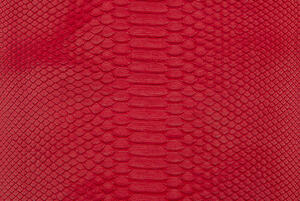In our last post, we discussed in brief the three different types of python skin that are commonly traded: the short tail python, the Burmese python, and the diamond python.
Today, we’re digging into the details regarding the short tail python as an exotic leather.
Measurements
 Of the three most commonly-traded python species, the Brongersmai, or short tail python, is the smallest. However, this does not mean that the short tail python is a small animal by any means.
Of the three most commonly-traded python species, the Brongersmai, or short tail python, is the smallest. However, this does not mean that the short tail python is a small animal by any means.
On average, the short tail python tends to be 1.6 meters (roughly 5.2 ft.), and 28 cm (11 inches) wide at the widest point of the belly, slowly tapering to 15 cm (5.9 inches) at the ends. This means that for the average short tail python skin, you can expect to have about 5 sq. ft. (0.46 m2) of skin.
The reason the amount of skin you can get from a single hide is so high is that the tapering of the hide is very slight until you near the ends. This width and length makes the short tail python great for use in many different applications, such as handbags, belts, footwear, etc.
Appearance
 The center belly scales of the short tail python tend to be several times wider than the rest of the scales on the hide. This makes the belly scales of the hide stand out next to the rest of the animal’s smaller scales, drawing the eye easily in any item that displays belly scales. In fact, the center belly scales are substantially wider on the short tail python (35 mm in the center and 20 mm toward the ends) than they are on the Burmese (25 mm in the center and 20 cm toward the ends).
The center belly scales of the short tail python tend to be several times wider than the rest of the scales on the hide. This makes the belly scales of the hide stand out next to the rest of the animal’s smaller scales, drawing the eye easily in any item that displays belly scales. In fact, the center belly scales are substantially wider on the short tail python (35 mm in the center and 20 mm toward the ends) than they are on the Burmese (25 mm in the center and 20 cm toward the ends).
Contrary to the other species, these hides are pnly available in a back-cut bleached style. A back cut means that the hide was split down the back, leaving the belly scales intact and on display in the center of the piece. Bleaching the hide removes the natural markings from the hide, ensuring a smooth, consistent color once the hide is dyed.
One other thing that you might notice about short tail python hides is that they tend to be thicker than the Burmese python’s hide. The short tail python is approximately 0.6/0.8 mm thick, while the Burmese averages merely 0.5/0.7 mm. This gives your product a little fuller body and plush hand.
Tips for Working with Short Tail Python Hide
If you want to reduce wear and tear on your sewing needles, or just want to have a thinner, more flexible hide, you may want to sand down the underside of the hide to reduce its thickness. When doing so, it is important to be careful not to reduce the hide’s thickness too much, or else you risk compromising the integrity of the hide.
Treating the scales of the short tail python with conditioner formulated for snake hides can help add luster to your finished product, making it more attractive when on display, in addition to providing protection against contaminants.
While short compared to the other species of python that are commonly available, the amount of skin you can get with a single short tail hide is still considerable. In many cases, this might mean that you will have some leftover hide after you cut out your panels for your project. Depending on the size of the scraps you’re left with, you may be able to make other items from the spare hide, such as watch straps, wrist bands, wallets, and other small accessory items to go with your primary product.
As a material for exotic leather projects, short tail python hide is an excellent choice for meeting the needs of your most discerning clients. With the bleached appearance and wide belly scales, you can easily create a sleek piece that draws the eye.
Interested in working with short tail python skin, or any other exotic leather? Contact Pan American Leathers today for a free consultation using the link below:



